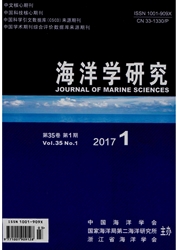

 中文摘要:
中文摘要:
使用World Ocean Altas2009提供的气候态月平均温度、盐度和磷酸盐浓度资料,以及Globalview和NCEP的大气资料,借助较为可靠的经验公式,估算了东海海表CO2分压(ρCO2)和海-气CO2通量的平均分布特征和季节变化。结果表明,pCO2的空间分布形态四季大体相同,但其强度随季节变化,春、冬季低,夏、秋季高。CO2通量在东海陆架区为汇,汇的强度从Nw向SE逐渐减弱;在黑潮区为源,强度从SW向NE逐渐减弱。东海整体于春、冬季为CO2的汇,夏、秋季为CO2的源。进一步分析东海pCO2和CO:通量季节变化的主要影响因子表明,东海海表pCO2变化主要受温度控制,而在陆架区,盐度和磷酸盐的作用不可忽略。东海整体CO2通量变化在4至10月由风速主导,11月至翌年3月由海表pCO:控制;陆架区CO2通量的季节变化主要由风速决定;黑潮区CO2通量的变化在夏季由风速主导,秋季由风速和pCO2共同影响。
 英文摘要:
英文摘要:
Using the empirical formula of TSUNOGAI et al, a preliminary study was made on the climatological distribution and seasonal variation of the sea surface pCO2 and air-sea C()2 flux in the East China Sea, and the influence of sea surface temperature, salinity, phosphate concentration and wind speed. The formula was based on environmental parameters (sea surface temperature, salinity and phosphate concentration). The data used were from WOA09 (monthly mean climatological sea surface temperature, salinity and phosphate concentration), Globalview (atmospheric pCO2 ) and NCEP (monthly mean wind speed). The spatial distribution of the calculated pCO2 maintains a gradually increasing trend from the northwest to the southeast while its magnitude varies significantly with seasons, lower in spring and winter, higher in summer and autumn. Space-time pattern of the CO2 flux varies obviously, the continental shelf region as a whole is the convergence of CO2 from atmosphere, while the Kuroshio region is the source. The convergence intensity gradually weakens from the northwest to the southeast and that of source strengthens from the northeast to the southwest. The East China Sea uptake CO2 from atmosphere in spring and winter while release CO2 to atmosphere in summer and autumn. Analysis of seasonal change of the sea surface pCO2 in the East China Sea shows that SST is its main controlling factor. They change in the same phase, reache the maximum in summer and minimum in winter. In the Kuroshio area, salinity and phosphate concentration remains stable all the year round, their seasonal variations could be neglected and the variation of pCO2 is completely controlled by temperature. In the continental shelf area, the changes of salinity and phosphate concentration are contrary to that of temperature, but the magnitude is relatively low. The seasonal change of pCO2 is still controlled by SST in most of the months except June, July and December, when the role of salinity and phosphate concentration tops that of
 同期刊论文项目
同期刊论文项目
 同项目期刊论文
同项目期刊论文
 Three-dimensional properties of mesoscale eddies in the South China Sea based on eddy-resolving mode
Three-dimensional properties of mesoscale eddies in the South China Sea based on eddy-resolving mode On the role ofwind and tide in generating variability of Pearl River plume during summer in a couple
On the role ofwind and tide in generating variability of Pearl River plume during summer in a couple Target observations for improving initializationof high-impact ocean-atmospheric environmentalevents
Target observations for improving initializationof high-impact ocean-atmospheric environmentalevents Validating satellite altimeter measurementsof internal tides with long-term TAO/TRITONbuoy observati
Validating satellite altimeter measurementsof internal tides with long-term TAO/TRITONbuoy observati On the role of wind andtide in generating variability of Pearl River plume during summer in a couple
On the role of wind andtide in generating variability of Pearl River plume during summer in a couple Seasonal prediction of East Asian monsoon precipitation:skill sensitivity to various climate variabi
Seasonal prediction of East Asian monsoon precipitation:skill sensitivity to various climate variabi 期刊信息
期刊信息
